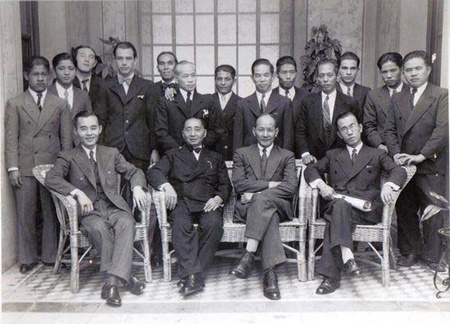The migration was a massive migratory movement of Japanese to countries such as the United States, Peru, Brazil, among others. It began due to the economic and social situation that Japan was experiencing after the agrarian reforms and changes in socioeconomic relations during the Meiji period 1 , turning Japan into a modern state. This resulted in the migration of the rural population to large cities and their overpopulation.
Migration to Argentina began in the 19th century, dividing into two periods. The pre-war period (1900 – 1939), with the arrival of Japanese through three routes, one direct through the port of Buenos Aires, and two indirect routes (landing) from Brazil and Peru. Migration during this period was free, since there were no contracts with Argentina for the reception of migrants, the second characteristic being a spontaneous movement, stimulated by the good economic situation that our country was experiencing (Onaha, 2011). During this period, the region of origin was the Okinawa prefecture, due to the historical process that the islands were going through. The situation of unemployment and famine as a consequence of the island's incorporation into the Japanese Empire led the Okinawan population to migrate to other countries.
The second period runs from 1945 to 1980. The Japanese government intensified its migration policy and signed migration treaties with different Latin American countries, with the intention of decompressing the situation that the country was experiencing, such as the overpopulation caused by the repatriation of soldiers from colonies. Japanese, unemployment and famine resulting from the war. Argentina was one of the first destinations chosen by migrants who, during this period, came from different prefectures in Japan, not just Okinawa. What characterized Argentina during this period was that migration was never cut off because this country did not break ties with Japan during World War II.
The settlement of Japanese people will take place in all the provinces of the country, in some they had greater influx and in others less. This article will detail the Japanese migration process to the province of Salta, its history and the founding of the Japanese Association of Salta as a space for coexistence and cooperation of migrants.
Salta, Argentina
To situate the reader, Salta is a province in northwest Argentina, forming part of the twenty-three provinces that make up the country. It is located in the northwest, bordering Chile (to the west), Paraguay (to the northeast) and Bolivia (to the north). It also borders the provinces of Jujuy, Formosa, Chaco, Santiago del Estero, Tucumán and Catamarca. Its capital is the City of Salta.
To carry out the historical reconstruction of the Japanese migration to Salta, interviews with relatives and their descendants are used, since there is no official record on the subject. However, Mercedes Labarthe's thesis (1982) describes that the first to arrive are Ushi Toma Oshiro in 1813 and then Nagi in 1915. According to interviews conducted, this information changes completely. The migration of Japanese would begin around 1917, continuing during the 1920s and 1930s, reducing in the postwar period.
For the descendants interviewed, the first to arrive in Salta were Choko Yamada in 1916, Eisuke Iwashita in 1918 and Minwa Higa, around 1920. During the 1920s the rest would arrive, the wave extending until the 1930s, prior to the Second World War. World War. During the 1930s another large group of migrants would arrive.
For the second period, migration was considerably reduced, with about 5 or 6 migrants settling in the province. This means that the Japanese community in Salta is small, unlike other provinces such as Buenos Aires or Misiones, where migration was greater even until recent years.

As previously stated, migration was indirect (without a fixed destination) and free. Emphasizing the first characteristic, the Japanese were exploring the places where they arrived, if they found work and managed to save to be able to live fairly well, they decided to settle in that chosen place, first. If this was not met, they changed the destination. Many times they settled on lands that the Japanese government had purchased to form colonies, but these were in poor conditions, with infertile lands and deplorable sanitary conditions, so they decided to abandon them. Thus, they ended up working on plantations (such as coffee plantations in Brazil) as laborers, but the living conditions were deplorable and with low wages, so they fled from labor contracts.
In the case of Salta, the Japanese arrived at the ports of Peru and Brazil, as their first destination after the ban imposed in the United States and countries close to it. From there, many moved to Argentina in search of other opportunities, since at that time the country was in a good economic situation. Some also boarded at the port of Buenos Aires and worked in the province for a certain time. In the second, post-war period, the number of Japanese who arrived in the province was reduced, and even the path they crossed was much shorter. This is due to the planned migration that Japan had carried out, signing different contracts with Latin countries.
The reasons that led them to go abroad was the idea of “escape” from their country, where finding work was difficult and famine was greater every day, especially in the southern islands (Okinawa) which, upon being incorporated to the Japanese empire long after its formation, they had lost their fields, had no jobs and were discriminated against by the rest of the population for having a different culture. Okinawan culture was influenced by China because it was an independent kingdom for a long time, not understood by the Japanese on the rest of the island.
“He arrived with other Japanese. They were escaping the war in Okinawa, famine and poverty; So almost all the men of legal age got on boats and left aimlessly.” (G. Chinen, personal interview, October 1, 2017).
On the other hand, the consequences of the wars with China and Russia, at first, and then the Second World War had caused the decision to seek better living conditions. They wanted to climb socially in another country because they couldn't in their own, and migration was the opportunity to achieve it.
“In 1954, almost 10 years after the end of the war, food was scarce in Japan and the fields did not have time to harvest the crops that were harvested before they matured. The pumpkin was plucked when it was the size of a fist,” he remembers. That's why Hiroyuki decided to leave his homeland. (Interview with Hiroyuki Nigatake, conducted by the newspaper El Tribuno).
All these experiences lived by the Japanese generated a certain feeling of unity being in a foreign country. It was also because many came from the same province in Japan. In this way, the different associations and migrant groups in the country will emerge. In Salta, migrants from the Island of Okinawa and the Kagoshima prefecture will predominate, with those from other parts being to a lesser extent.
This is also noticeable in the different attitudes and practices, according to the descendants. Those who came from Okinawa were happier, more open and more jovial; On the other hand, those who were from the rest of the island were a little more closed. Thus, as those who come from other prefectures testify, the Okinawans were different, they could not understand them and their culture was different.

Regarding this, Ichikawa Shinichi (2004) explains that, from a cultural point of view, Okinawa had different mythological and religious traditions. Originally, the Ryûkyû were a matriarchal society. The culture of the Ryûkyû was also greatly influenced by Chinese culture. On the other hand, the language spoken in Okinawa is different from standard Japanese. Uchinaguchi (the name for the dialect used in Okinawa, a language that had been the target of intense elimination policies) was spoken in family and everyday contexts; the Japanese of Hondo 2 were not able to understand it (Matsuyama, 2010).
“Okinawa, they are different cultures, Okinawa had the influence of Chinese who entered. I don't understand their culture, they differ, there is a difference, the Japanese on the one hand and the Okinawans on the other. "I don't understand the thinking, it was a militarism that existed and those from Okinawa suffered many things." (T. Matsumoto, personal interview, May 31, 2017).
Sayuri Matsuyama (2010) comments that Okinawa Prefecture has historically occupied a subordinate ethnic and political position within Japan. In the Peruvian and Argentine colonies, the majority of immigrants came from this prefecture, who settled in Latin America at a time when they defined themselves as Okinawans rather than Japanese. This affiliation was connected to the intense discrimination imposed by the nation's identity discourse and the delay in the economic industrialization of the island. Despite making up the majority of Japanese willing to emigrate, Okinawans were considered by state officials of the entities that promoted and recruited migrant workers as “unworthy Japanese” to represent Japan.
“Of the Iseis who came to Salta and Jujuy, 70% are Okinawans, not Japanese, this person's father was born in Okinawa, not in Japan, look, our warriors from the province of Satsuma dominated the island at the end of the last century and since then the island belongs to Japan. They have different customs, a different dialect (if a Japanese listens to two Okinawans speaking, he will not understand them), and even their race is different.” (Interview conducted by Marcela Labarthe with an issei 3 , Bachelor's thesis, 1982). In Salta this difference between Japanese and Okinawans is no exception, as can be seen in the previous quote. The descendants themselves comment that they were totally different and their unity was greater as they came from the same place.
On the other hand, in Salta the majority of migrants who arrived were men, since they came alone, often leaving their wives and children in Japan or because they were single. The Japanese diasporas intended to return to their country and family once they saved up. During the first pre-war period we find a spontaneous migration. Many times these plans were affected or they lost contact, so they decided to remarry. Some descendants, when they had to travel to Japan and show the koseki (family record), noticed that there was another family that they were completely unaware of.
Even though the majority who migrated were single, there were also Japanese who migrated with their wives. Newly married, they decided to leave Japan in search of better living conditions. The phenomenon called “mail order brides” did not take place in the province, it consisted of Japanese organizations that were in Argentina contacting Japanese women and, through letters, meeting their future husbands. When the agreement was finalized, they were brought to the country to marry the Japanese who remained single. It is interesting to see how many Japanese became depressed for the simple fact of not being able to marry Japanese women. And many times these women, upon arriving in the country, found a reality totally different from what they had dreamed of, ending up disappointed and no longer having the possibility of returning.
Grades:
1. 明治維新(めいじいしん, Meiji Ishin )was a series of events that changed the social and political structure. Ran from 1866 to 1870, beginning the Meiji Era. Ishin (維新) means restoration, meiji is composed of the kanji for clear/light (明) and for cure/heal/remedy (治).
2. 本土(ほんど, Hondo ): Main island of Japan.
3. Japanese migrant. It translates as first generation.
© 2022 Sofia Garzon



